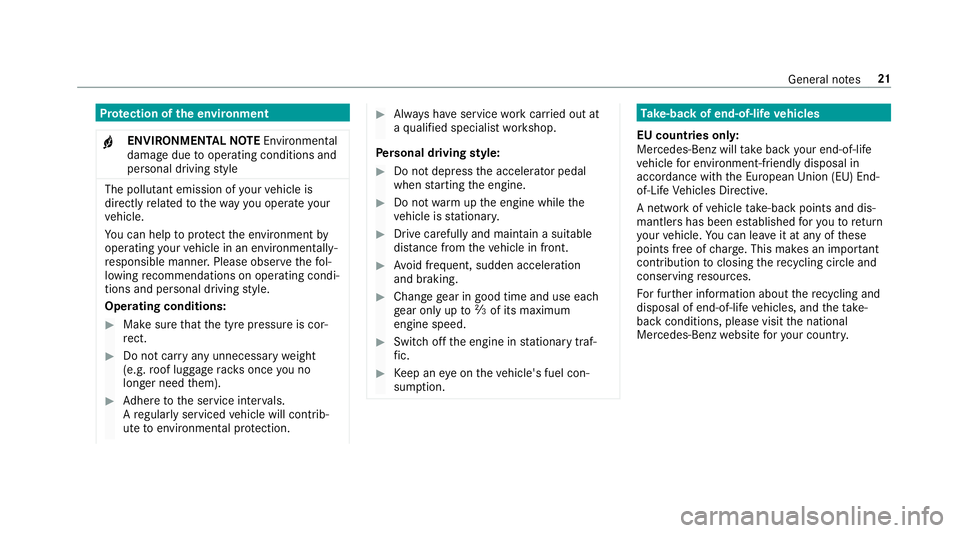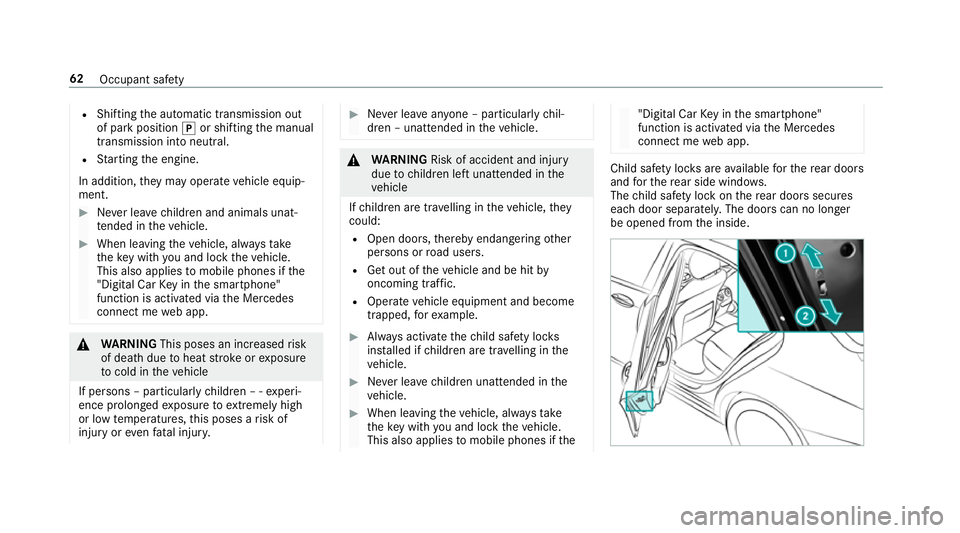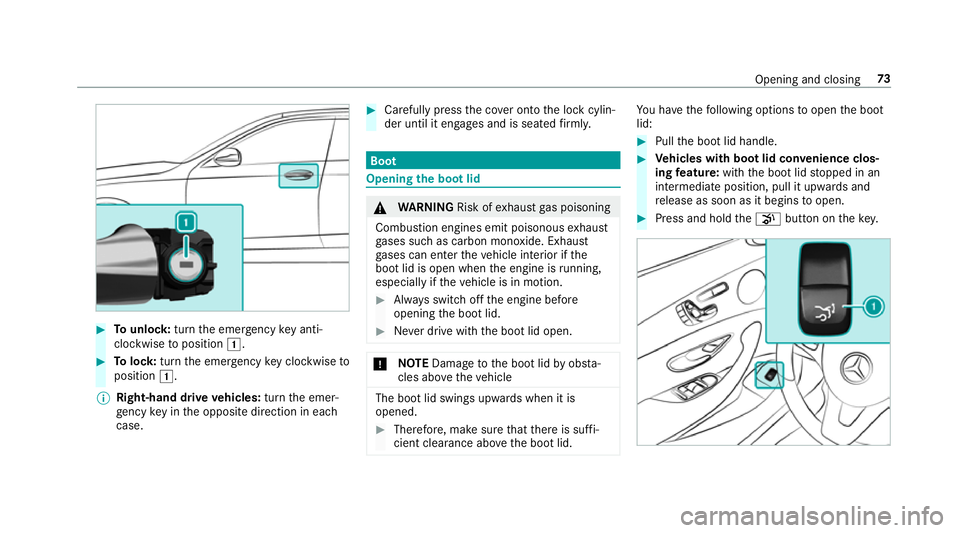2016 MERCEDES-BENZ E-CLASS SALOON engine
[x] Cancel search: enginePage 6 of 557

Driving and pa
rking ................................. 15 3
Driving ........................................................ 15 3
DY NA MIC SELECT switch ............................1 60
Manual transmission ................................... 161
Au tomatic transmission .............................. 16 2
Re fuelling .................................................... 16 6
Pa rking ...................................................... .172
Driving and driving sa fety sy stems .............1 79
Tr ailer hit ch................................................. 237
Bicycle rack ................................................. 241Instrument Display and on-board
compu ter.................................................. 244
Instrument display overview ...................... .244
Overview of the buttons on thesteering
wheel ..........................................................2 45
Operating the on-board computer .............. 24 6
Displ ays in the multifunction display ........... 247
Ad justing the instrument lighting ................2 48
Menus and submenus ................................. 24 8
Head-up Display ......................................... 255 LI
NG UATRONIC ......................................... 257
Ope rating sa fety ......................................... 257 Operation ................................................... 257
Using LINGU ATRO NIC ef fectively ............... 259
Essential commands .................................. 259 Multimedia sy
stem .................................. 268
Overview and operation .............................. 268
Sy stem settings .......................................... 276
Na vigation .................................................. 284
Te lephone .................................................. .307
Online and Internet functions ..................... 329
Media ......................................................... 337
Ra dio .......................................................... 349
TV ............................................................... 352
Sound ......................................................... 360 Main
tenance and care ............................. 363
ASS YST PLUS service inter val display ........ 363
Engine compartment .................................. 364
Cleaning and care ...................................... .371 Breakdown assistance
............................37 9
Emergency .................................................. 379
Flat tyre ...................................................... 381 Battery (vehicle) ......................................... 387
To
w starting or towing away ....................... 392
Electrical fuses ........................................... 398 Wheels and tyres
..................................... 401
Noise or unusual handling characteristics .. 401
Re gular checking of wheels and tyres ......... 401
No tes on snow chains ................................ .401
Ty re pressure .............................................. 402
Wheel change ............................................ .409
Emergency spa rewheel .............................. 419 Te
ch nical data .......................................... 421
No tes on tech nical da ta.............................. 421
On-board electronics .................................. 421
Ve hicle identification plate, VIN and
engine number ...........................................4 23
Operating fluids .......................................... 425
Ve hicle data ................................................ 433
Tr ailer hit ch................................................ 435 Contents
3
Page 14 of 557

1
Speedom eter →
24 4
2 ÷ ESP®
3 #! Turn signal light →
12 5
4 Ð Steering assis tance malfunction
5 Multifunction displ ay →
247
6 ! ABS malfunction
7 ; Engine diagnosis
8 Rev counter →
24 4
9 % Diesel engine: preglow
A ! Electric pa rking brake applied (red)
B J Brakes (red)
C # Electrical fault
D · Distance warning
E ? Coolant too hot/cold
F Coolant temp erature display →
24 4 G
J Brakes (yell ow)
H ! Electric pa rking brake (yellow)
I 6 Restra int sy stem →
31
J ü Seat belt is not fastened
K j Trailer hit chis not operational or is swivel‐
ling
L T Standing lights →
12 3
M Fuel le vel display
8 Fuelreser vewith fuel filler cap location
indicator
N K Main beam →
12 5
O L Dipped beam →
12 3
P R Rear fog light →
124
Q h Tyre pressure monitoring sy stem
R å ESP®
OFF At
aglance – Warning and indicator lamps 11
Page 16 of 557

1
Speedom eter →
24 4
2 ü Seat belt is not fastened
3 #! Turn signal light →
12 5
4 Multifunction display →
247
5 Rev counter →
24 4
6 å ESP®
OFF
÷ ESP®
7 K Main beam →
12 5
L Dipped beam →
12 3
T Standing lights →
12 3
8 ? Coolant too hot/cold
9 Coolant temp erature display →
24 4
A · Distance warning
B Ð Steering assis tance malfunction
C # Electrical fault D
J Brakes (red)
E Fuel le vel display
F 8 Fuelreser vewith fuel filler cap location
indicator
G R Rear fog light →
124
H 6 Restra int sy stem →
31
I % Diesel engine: preglow
J ; Engine diagnosis
K J Brakes (yellow)
L ! Electric pa rking brake applied (red)
M h Tyre pressure monitoring sy stem
N ! ABS malfunction
O ! Electric pa rking brake (yellow)
P j Trailer hit chis not operational or is swivel‐
ling At
aglance – Warning and indicator lamps 13
Page 24 of 557

Pr
otection of the environment
+ ENVIRONMENTAL
NOTEEnvironmental
dama gedue tooperating conditions and
personal driving style The pollutant emission of
your vehicle is
directly related tothewa yyo u operate your
ve hicle.
Yo u can help toprotect the environment by
operating your vehicle in an environmentally-
re sponsible manner. Please obser vethefo l‐
lowing recommendations on ope rating condi‐
tions and pe rsonal driving style.
Operating conditions: #
Make sure that the tyre pressure is cor‐
re ct. #
Do not car ryany unnecessary weight
(e.g. roof luggage rack s once you no
lon ger need them). #
Adhere tothe service inter vals.
A regularly serviced vehicle will contri b‐
ute toenvironmen tal pr otection. #
Alw ays ha veservice workcar ried out at
a qu alified specialist workshop.
Pe rsonal driving style: #
Do not depress the accelera tor pedal
when starting the engine. #
Do not warm upthe engine while the
ve hicle is stationar y. #
Drive carefully and maintain a suitable
di st ance from theve hicle in front. #
Avoid frequent, sudden acceleration
and braking. #
Change gear in good time and use each
ge ar on lyup toÔ of its maximum
engine speed. #
Switch off the engine in stationary traf‐
fi c. #
Keep an eye on theve hicle's fuel con‐
sum ption. Ta
ke -back of end-of-life vehicles
EU countries onl y:
Mercedes-Benz will take back your end-of-life
ve hicle for environment-friendly disposal in
accordance with the European Union(EU) End-
of-Life Vehicles Directive.
A network of vehicle take -ba ckpoints and dis‐
mantlers has been es tablished foryo uto return
yo ur vehicle. You can lea veit at any of these
points free of charge . This makes an impor tant
contribution toclosing there cycling circle and
conse rving resources.
Fo r fur ther information about there cycling and
disposal of end-of-li fevehicles, and theta ke-
back conditions, please visit the national
Mercedes-Benz website foryo ur count ry. Gene
ral no tes 21
Page 48 of 557

or
- When theve hicle is towing a trailer and
th ere is a risk of a rear impact.
R The brakes are not applied:
- Whilst driving.
or
- When entering or exiting a parking space
using Parking Pilot. Information on PRE-
SAFE®
Impulse Side If an imminent side impact is de
tected, PRE-
SA FE®
Impulse Side can pre-emptively mo vethe
front-seat vehicle occupant's upper body
to wa rdsth e cent reoftheve hicle. It does this by
ra pidly inflating an air cushion in the outer seat
side bols ter of the seat backrest on the side on
which the impact is anticipated. This increases
th e dis tance between the door and theve hicle
occupant.
If PRE-SAFE ®
Impulse Side has been deplo yed or
is faulty, the display message PRE-SAFE impulse side inoperative See Owner's Manual
is dis‐
pla yed (→ page 438). Children in
theve hicle Note
s onthe safe transportation of children &
WARNING Risk of accident and inju ry
due tochildren left unat tended in the
ve hicle
If yo u lea vechildren unat tended in theve hi‐
cle, they may be able toset theve hicle in
motion, forex ample by:
R Releasing the parking brake.
R Shifting the automatic transmission out
of park position jor shifting the manual
transmission into neutral.
R Starting the engine.
In addition, they may operate vehicle equip‐
ment. #
Never lea vechildren and animals unat‐
te nded in theve hicle. #
When leaving theve hicle, alw aysta ke
th eke y with you and lock theve hicle.
This also applies tomobile phones if the
"Digital Car Key in the smartphone"
function is activated via the Mercedes
connect me web app. &
WARNING This poses an increased risk
of death due toheat strokeorexposure
to cold in theve hicle
If persons – particularly children – ‑ experi‐
ence prolonged exposure toextremely high
or low temp eratures, this poses a risk of
injury or evenfa ta l injur y. #
Never lea veanyone – pa rticularly chil‐
dren – unat tended in theve hicle. &
WARNING Risk of bu rns when thech ild
seat is exposed todirect sunlight
If th ech ild restra int sy stem is exposed to
direct sunlight or heat, parts could heat up. Occupant saf
ety45
Page 65 of 557

R
Shifting the automatic transmission out
of park position jor shifting the manual
transmission into neutral.
R Starting the engine.
In addition, they may operate vehicle equip‐
ment. #
Never lea vechildren and animals unat‐
te nded in theve hicle. #
When leaving theve hicle, alw aysta ke
th eke y with you and lock theve hicle.
This also applies tomobile phones if the
"Digital Car Key in the smartphone"
function is activated via the Mercedes
connect me web app. &
WARNING This poses an increased risk
of death due toheat strokeorexposure
to cold in theve hicle
If persons – particularly children – ‑ experi‐
ence prolonged exposure toextremely high
or low temp eratures, this poses a risk of
injury or evenfa ta l injur y. #
Never lea veanyone – pa rticularly chil‐
dren – unat tended in theve hicle. &
WARNING Risk of accident and inju ry
due tochildren left unat tended in the
ve hicle
If ch ildren are tra velling in theve hicle, they
could:
R Open doo rs,th ereby endangering other
persons or road users.
R Get out of theve hicle and be hit by
oncoming traf fic.
R Ope rate ve hicle equipment and become
trapped, forex ample. #
Alw ays activate thech ild saf ety loc ks
ins talled if children are tra velling in the
ve hicle. #
Never lea vechildren unat tended in the
ve hicle. #
When leaving theve hicle, alw aysta ke
th eke y with you and lock theve hicle.
This also applies tomobile phones if the "Digital Car
Key in the smartphone"
function is activated via the Mercedes
connect me web app. Child saf
ety loc ksare available forth ere ar doors
and forth ere ar side wind ows.
The child saf ety lock on there ar doors secures
each door separatel y.The doors can no longer
be opened from the inside. 62
Occupant saf ety
Page 67 of 557

Key
Overview of
key functions &
WARNING ‑ Thereis a risk of accident
and injury if you lea vechildren unat ten‐
ded in theve hicle
If ch ildren are left unat tended in theve hicle,
th ey could:
R open doo rs,th ereby endangering other
persons or road users.
R get out of theve hicle and be hit by
oncoming traf fic.
R ope rate ve hicle equipment.
Moreo ver,th ech ildren could also set the
ve hicle in motion by,fo rex ample:
R releasing the parking brake
R shifting the automatic transmission out of
park position P jor shifting manual
transmission into idle position.
R starting the engine. #
Never lea vechildren or animals unat‐
te nded in theve hicle. #
When leaving theve hicle, alw aysta ke
th eke y with you and lock theve hicle. #
Keep theve hicle key out of there ach of
ch ildren. *
NO
TEDama getotheke y caused by
magnetic fields #
Keep theke yaw ay from strong mag‐
netic fields. 1
Locks
2 Battery check lamp
3 Unloc ks
4 Opens/closes the boot lid
The key loc ksand unlo cksth efo llowing compo‐
nents:
R The doors
R The boot lid
R The fuel filler flap
If yo u do not open theve hicle within appr ox‐
imately 40 seconds af ter unlocking:
R The vehicle is loc ked again. 64
Opening and closing
Page 76 of 557

#
Tounlo ck:turn the emer gency key anti-
clo ckwise toposition 1. #
Tolock: turnthe emer gency key clo ckwise to
position 1.
% Right-hand drive vehicles: turnthe emer‐
ge ncy key in the opposite direction in each
case. #
Carefully press the co ver onto the lock cylin‐
der until it engages and is seated firm ly. Boot
Opening the bo
otlid &
WARNING Risk ofexhaust gas poisoning
Combustion engines emit poisonous exhaust
ga ses such as carbon monoxide. Exhaust
ga ses can enter theve hicle interior if the
boot lid is open when the engine is running,
especially if theve hicle is in motion. #
Alw ays switch off the engine before
opening the boot lid. #
Never drive with the boot lid open. *
NO
TEDama getothe boot lid byobs ta‐
cles ab ovetheve hicle The boot lid swings upwards when it is
opened.
#
Therefore, make sure that there is suf fi‐
cient clearance ab ovethe boot lid. Yo
u ha vethefo llowing options toopen the boot
lid: #
Pull the boot lid handle. #
Vehicles with boot lid conve nience clos‐
ing feature: withthe boot lid stopped in an
intermediate position, pull it upwards and
re lease as soon as it begins toopen. #
Press and hold thep button on thekey. Opening and closing
73